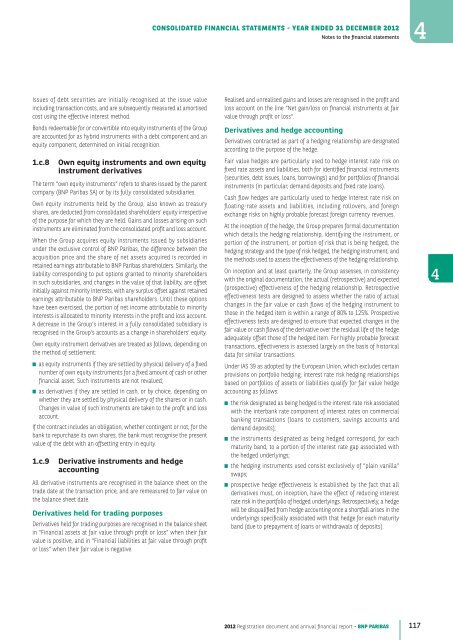2012 Registration document and annual financial report - BNP Paribas
2012 Registration document and annual financial report - BNP Paribas
2012 Registration document and annual financial report - BNP Paribas
- No tags were found...
You also want an ePaper? Increase the reach of your titles
YUMPU automatically turns print PDFs into web optimized ePapers that Google loves.
CONSOLIDATED FINANCIAL STATEMENTS - YEAR ENDED 31 DECEMBER <strong>2012</strong>Notes to the <strong>financial</strong> statements4Issues of debt securities are initially recognised at the issue valueincluding transaction costs, <strong>and</strong> are subsequently measured at amortisedcost using the effective interest method.Bonds redeemable for or convertible into equity instruments of the Groupare accounted for as hybrid instruments with a debt component <strong>and</strong> anequity component, determined on initial recognition.1.c.8Own equity instruments <strong>and</strong> own equityinstrument derivativesThe term “own equity instruments” refers to shares issued by the parentcompany (<strong>BNP</strong> <strong>Paribas</strong> SA) or by its fully consolidated subsidiaries.Own equity instruments held by the Group, also known as treasuryshares, are deducted from consolidated shareholders’ equity irrespectiveof the purpose for which they are held. Gains <strong>and</strong> losses arising on suchinstruments are eliminated from the consolidated profit <strong>and</strong> loss account.When the Group acquires equity instruments issued by subsidiariesunder the exclusive control of <strong>BNP</strong> <strong>Paribas</strong>, the difference between theacquisition price <strong>and</strong> the share of net assets acquired is recorded inretained earnings attributable to <strong>BNP</strong> <strong>Paribas</strong> shareholders. Similarly, theliability corresponding to put options granted to minority shareholdersin such subsidiaries, <strong>and</strong> changes in the value of that liability, are offsetinitially against minority interests, with any surplus offset against retainedearnings attributable to <strong>BNP</strong> <strong>Paribas</strong> shareholders. Until these optionshave been exercised, the portion of net income attributable to minorityinterests is allocated to minority interests in the profit <strong>and</strong> loss account.A decrease in the Group’s interest in a fully consolidated subsidiary isrecognised in the Group’s accounts as a change in shareholders’ equity.Own equity instrument derivatives are treated as follows, depending onthe method of settlement:■ as equity instruments if they are settled by physical delivery of a fixednumber of own equity instruments for a fixed amount of cash or other<strong>financial</strong> asset. Such instruments are not revalued;■ as derivatives if they are settled in cash, or by choice, depending onwhether they are settled by physical delivery of the shares or in cash.Changes in value of such instruments are taken to the profit <strong>and</strong> lossaccount.If the contract includes an obligation, whether contingent or not, for thebank to repurchase its own shares, the bank must recognise the presentvalue of the debt with an offsetting entry in equity.1.c.9Derivative instruments <strong>and</strong> hedgeaccountingAll derivative instruments are recognised in the balance sheet on thetrade date at the transaction price, <strong>and</strong> are remeasured to fair value onthe balance sheet date.Derivatives held for trading purposesDerivatives held for trading purposes are recognised in the balance sheetin “Financial assets at fair value through profit or loss” when their fairvalue is positive, <strong>and</strong> in “Financial liabilities at fair value through profitor loss” when their fair value is negative.Realised <strong>and</strong> unrealised gains <strong>and</strong> losses are recognised in the profit <strong>and</strong>loss account on the line “Net gain/loss on <strong>financial</strong> instruments at fairvalue through profit or loss”.Derivatives <strong>and</strong> hedge accountingDerivatives contracted as part of a hedging relationship are designatedaccording to the purpose of the hedge.Fair value hedges are particularly used to hedge interest rate risk onfixed rate assets <strong>and</strong> liabilities, both for identified <strong>financial</strong> instruments(securities, debt issues, loans, borrowings) <strong>and</strong> for portfolios of <strong>financial</strong>instruments (in particular, dem<strong>and</strong> deposits <strong>and</strong> fixed rate loans).Cash flow hedges are particularly used to hedge interest rate risk onfloating-rate assets <strong>and</strong> liabilities, including rollovers, <strong>and</strong> foreignexchange risks on highly probable forecast foreign currency revenues.At the inception of the hedge, the Group prepares formal <strong>document</strong>ationwhich details the hedging relationship, identifying the instrument, orportion of the instrument, or portion of risk that is being hedged, thehedging strategy <strong>and</strong> the type of risk hedged, the hedging instrument, <strong>and</strong>the methods used to assess the effectiveness of the hedging relationship.On inception <strong>and</strong> at least quarterly, the Group assesses, in consistencywith the original <strong>document</strong>ation, the actual (retrospective) <strong>and</strong> expected(prospective) effectiveness of the hedging relationship. Retrospectiveeffectiveness tests are designed to assess whether the ratio of actualchanges in the fair value or cash flows of the hedging instrument tothose in the hedged item is within a range of 80% to 125%. Prospectiveeffectiveness tests are designed to ensure that expected changes in thefair value or cash flows of the derivative over the residual life of the hedgeadequately offset those of the hedged item. For highly probable forecasttransactions, effectiveness is assessed largely on the basis of historicaldata for similar transactions.Under IAS 39 as adopted by the European Union, which excludes certainprovisions on portfolio hedging, interest rate risk hedging relationshipsbased on portfolios of assets or liabilities qualify for fair value hedgeaccounting as follows:■ the risk designated as being hedged is the interest rate risk associatedwith the interbank rate component of interest rates on commercialbanking transactions (loans to customers, savings accounts <strong>and</strong>dem<strong>and</strong> deposits);■ the instruments designated as being hedged correspond, for eachmaturity b<strong>and</strong>, to a portion of the interest rate gap associated withthe hedged underlyings;■ the hedging instruments used consist exclusively of “plain vanilla”swaps;■ prospective hedge effectiveness is established by the fact that allderivatives must, on inception, have the effect of reducing interestrate risk in the portfolio of hedged underlyings. Retrospectively, a hedgewill be disqualified from hedge accounting once a shortfall arises in theunderlyings specifically associated with that hedge for each maturityb<strong>and</strong> (due to prepayment of loans or withdrawals of deposits).4<strong>2012</strong> <strong>Registration</strong> <strong>document</strong> <strong>and</strong> <strong>annual</strong> <strong>financial</strong> <strong>report</strong> - <strong>BNP</strong> PARIBAS 117





